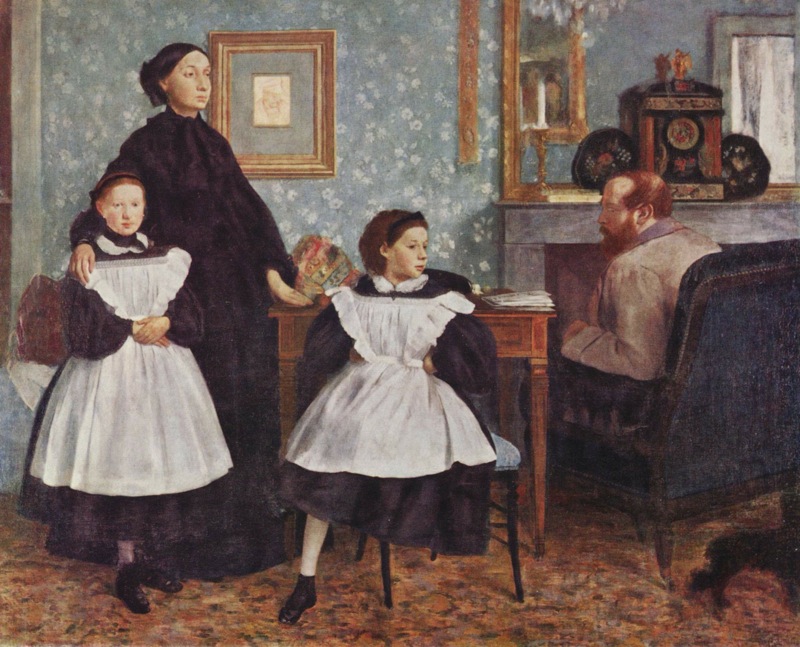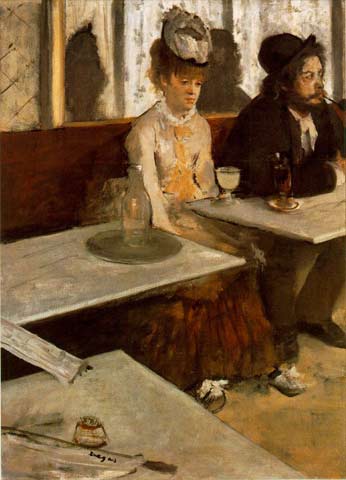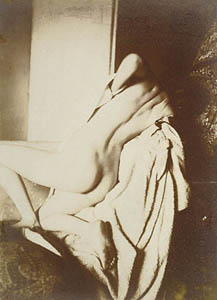One of the earliest recollections I have of a painting as a child is of Degas’s Bellelli Family.

Looking at the painting over the years it is clear that what attracted me to it is the photographic nature of the composition. Painted in 1860, in the early days of photography (Daguerrotypes first hit the market in 1839), the canvas is remarkable for several things. The informal pose of the paterfamilias on the right contrasts sharply with the stiff formality of the mother and her two daughters, the younger of whom appears to be an amputee! (She was, in reality, sitting on her tucked leg, the way kids do). Degas simply painted it as he saw it.
Now no one had done anything like this before, and Degas was lucky the Bellellis were affluent relatives (the mother in the portrait, Laura, was his aunt) for no one would have commissioned a portrait as strange, by contemporary tastes, as this. David Hockney would imitate his style a hundred years later by which time people were prepared to pay goodly sums to have their portraits painted in like manner.
Degas lived a long life, dying in 1917 at the age of 83, and the realism seen in his oil paintings taught me a great deal about photographic composition and seeing. No single painting does it better than “L’Absinthe”.

Painted sixteen years after The Bellelli Family, his powers of observation and composition are at their greatest in this superb painting. The effect is even greater if you can get to the Musee d’Orsay in Paris where it hangs for all to see – a modest sized canvas some 36″ x 24″in size. Absinthe is distilled from anise (similar to licorice) and wormwood. Poor distillation left behind toxic levels of chemicals, which could cause all sorts of harmful side effects ranging from vomiting to blindness. But none of that troubled the consumer who focused on the alcohol buzz (absinthe is some 60% alcohol) and the hallucinogenic high from the other chemicals present in abundance. Now you get the picture and the painting!
And what a remarkable painting it is. If you think Caravaggio’s ˜Conversion of St. Paul” is the greatest ˜wide-angle™ painting ever, well, “L’Absinthe” runs it a close second. The strong foreground with the knife cheekily signed by Degas leads the viewer, courtesy of those zig zagging diagonals, to the bombed pair in the rear. Except that they are almost out of the picture as if the painter himself had had a couple of shots during the process. The man’s pipe is cut off and he gazes out of the frame. The young woman is nothing less than a portrait of despair itself. The pair cast strong shadows on the wall behind. And you think Brassai invented this kind of thing?
Now I have no facts and figures to back this up, but I would bet that the average photographer rarely looks at a painting, even less thinks about painted art. What a shame for there is so much there to excite the eye and stir the imagination and those are two of the reasons we look at art. The third is to enjoy that sense of aesthetic satisfaction which good art provides. Not a bad definition, come to think of it, as to what exactly constitutes ˜art”. It is that which arouses the aesthetic senses.
Degas took up photography at the tender age of 61 and immediately set to recording that which he wanted to paint, except he did it with the compositional eye of a master.

Enhance your vision and imagination. Add a book of Degas’s paintings to your library.